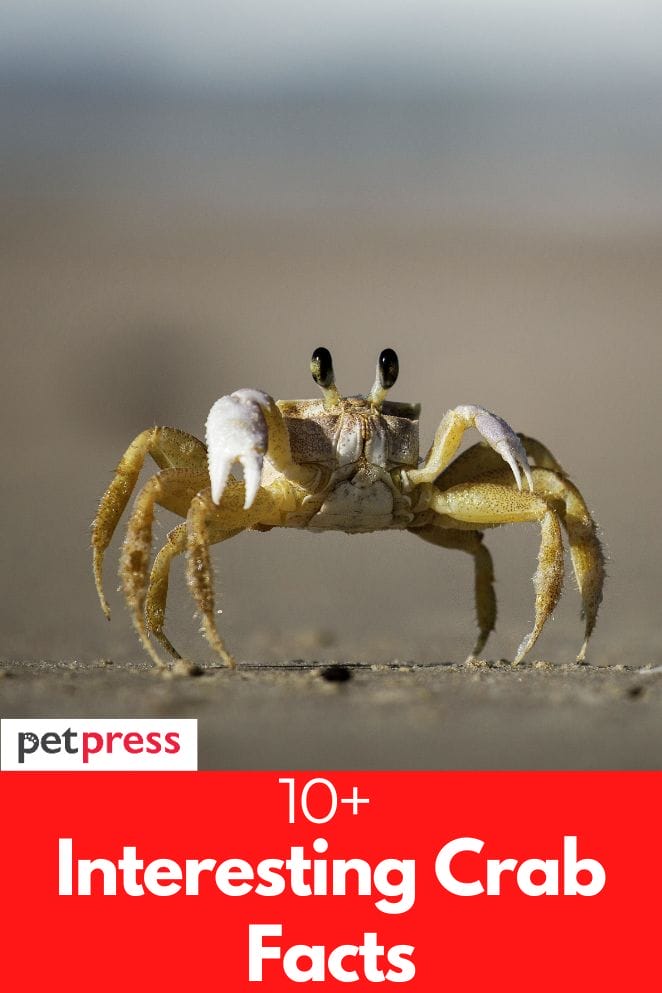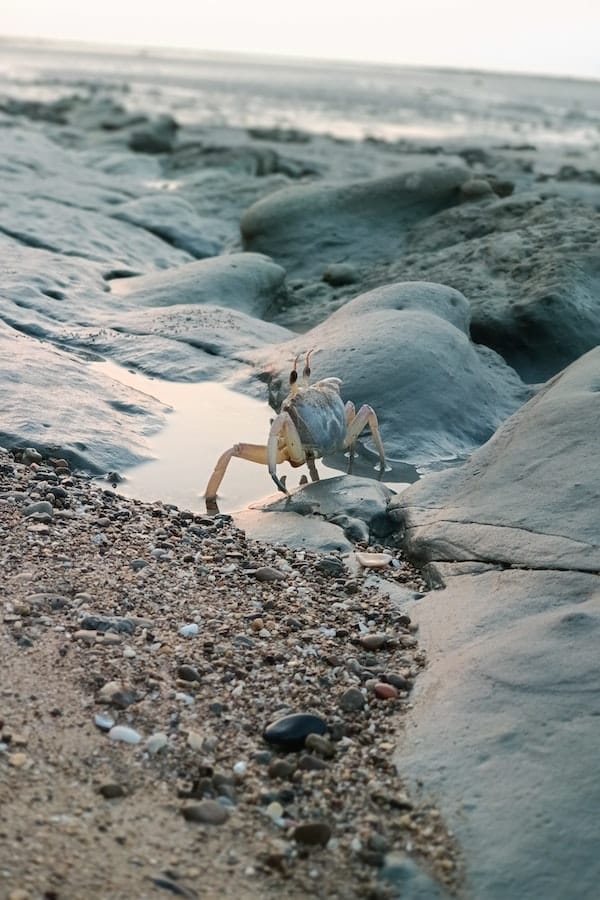
Crabs may not be the most glamorous of sea creatures, but they are incredibly fascinating.
Crabs are members of the crustacean family and can be found in many different habitats, from shallow reefs to the ocean’s depths.
They come in various shapes, sizes, and colors, making them both interesting and beautiful creatures. Here are some fun facts about crabs that you may not know. Enjoy!
Fact #1: Crabs can be found in all of the world’s oceans.
Crabs are incredibly versatile creatures and can be found in every ocean throughout the world.
The most familiar crab species live near shorelines and shallow reefs, but some species have been found at depths of up to 6 miles below sea level!
Crabs can live in various habitats depending on their species, including mud flats, sandy bottoms, and rocky outcroppings.
They have also ventured onto land in their search for food. No matter the ocean, crabs are sure to be found!
Fact #2: Crabs can live up to 30 years.
Crabs have the potential to live for a very long time. Many species of crabs, such as the Japanese spider crab, can survive for as many as 30 years!
That’s almost a third of a century!
Of course, this depends on the environment and food availability for the crab.
In general, crabs tend to reach their full lifespan in areas with plenty of food and shelter from predators.
As a result, most crabs live close to shorelines or beneath rocks and coral reefs.
Along with their long lifespans, crabs also have impressive regenerative capabilities – meaning they can regrow limbs and other body parts when necessary!
Fact #3: Crabs are omnivores.

Crabs are considered to be omnivorous creatures, meaning they eat both plants and animals.
In the wild, crabs feed on a variety of things, such as plants, algae, worms, mollusks, smaller fish and crustaceans.
They have been known to scavenge for food on the ocean floor or near shorelines.
Some species of crabs are also opportunistic feeders and will eat anything they can find – including carrion!
In captivity, many crabs have their diets supplemented with special meals that are tailored to their species.
These meals often include fruits, vegetables, and other proteins or vitamins necessary for a healthy life.
Fact #4: Some crabs have an extra set of claws.
Not all crabs are created equal – some species, such as the fiddler crab and the mitten crab, are equipped with an extra set of claws.
For example, male fiddler crabs possess one large claw and one small claw, while female fiddler crabs only have one claw.
This specialized set of claws helps the crab detect vibrations in the water, allowing it to identify potential predators or prey.
On the other hand, mitten crabs possess two large claws that are used for digging into sand and mud to create a burrow to live in.
The extra set of claws also gives these species an advantage in finding food and defending themselves.
Fact #5: Crabs can regenerate lost limbs.
One of the most remarkable features of crabs is their ability to regenerate lost body parts, such as claws, legs, and antennae.
This amazing process begins with forming a small bud at the site of the amputation, which then grows into a fully formed limb within a few weeks.
In some cases, the limb may even be larger than the original!
The regenerative abilities of crabs are due to their remarkable immune systems, which allow them to heal quickly and effectively.
This process allows them to survive in their challenging marine habitats and live as usual!
Fact #6: Crabs use their claws to communicate with each other.
Crabs are incredibly social creatures and use various methods to communicate with one another.
One of the most common ways for crabs to interact is through waving and touching their claws together.
This is known as “claw-waving” and is mainly used by male crabs during courtship to signal their interest in a female.
Additionally, crabs will also use their claws to gesture threats and warnings to other crabs or predators.
This behavior serves as an essential method of communication for the species, allowing them to interact with one another to survive and thrive in their environment!
- Related post: Species of Hermit Crabs: Guide, Trivia & More
- Related post: Best Names for Hermit Crabs
Fact #7: Crabs can swim.

Contrary to popular belief, most species of crabs are actually quite capable swimmers!
In fact, some crabs have been known to travel up to 8 miles (13 km) in a single day.
The key to their swimming ability lies in their powerful legs, which can propel the crab through the water with surprising speed and agility.
Additionally, some species of crabs even have special swimming appendages that allow them to navigate their aquatic environment more easily.
This ability to swim helps crabs avoid danger in the wild, as well as find food sources in deeper waters.
Fact #8: Crabs are an important part of the ocean food chain.
As marine scavengers, crabs play a vital role in the ocean ecosystem by consuming decaying organic matter and recycling essential nutrients back into the environment.
This process helps to maintain a healthy balance of nutrients in the ocean and allows other species to thrive.
Additionally, crabs are an important food source for many marine creatures, including larger fish, sea birds, and even humans.
Not only do they provide sustenance to many animals, but their consumption also helps to keep the population of certain prey species in check.
Fact #9: Crabs can live on land and in water.
It may come as a surprise, but certain species of crabs can live on land and in the water.
These semi-terrestrial crabs spend most of their time scavenging for food in the ocean but can also survive on land for long periods of time.
They have special adaptations that allow them to breathe out of the water and remain hydrated by absorbing moisture from their environment.
Additionally, these species of crabs are incredibly resilient and can withstand extreme temperatures and weather conditions.
This ability to live on land and in the water gives them a distinct advantage over many other aquatic species.
Fact #10: Crabs have been around for millions of years.
Crabs are among the oldest animals in the world, having first appeared on earth more than 200 million years ago!
They have remained virtually unchanged over the course of their long history and can still be found in many parts of the world.
This remarkable longevity is partly due to their tough exoskeletons, which protect them from predators and allow them to survive even the harshest conditions.
Additionally, crabs possess several unique traits that have enabled them to survive and thrive in different habitats over the years.
This makes them a truly ancient species with an incredibly diverse and fascinating history!
Fact #11: Crabs are an important food source in many cultures.
Crabs have long been a popular food source around the world, particularly in coastal regions where they can be found in abundance.
In many cultures, crabs are a staple of the local cuisine and can be prepared in a variety of delicious dishes.
Whether boiled, steamed, or stir-fried, crab meat is known for its sweet and succulent flavor, which makes it an ideal ingredient for all kinds of recipes.
Additionally, due to their high nutritional value, crabs are a healthy source of protein and essential vitamins and minerals.
For this reason, they have become an important part of many cultural cuisines around the globe.
Fact #12: Crabs can reproduce both sexually and asexually.

Crabs are capable of reproducing both sexually and asexually, depending on the species.
Most crabs reproduce by mating with another crab, which is done through a process called “budding.”
During this process, two crabs transfer sperm to each other in order to fertilize the eggs inside one of their bodies.
This form of reproduction is common among most species of crabs.
However, some species are capable of asexual reproduction, meaning they do not require another crab for mating and can reproduce independently.
This process involves the crab shedding its exoskeleton and growing a new one with fertilized eggs inside.
Asexual reproduction allows these crabs to repopulate quickly and can be a useful adaptation in times of food scarcity.
Overall, crabs are fascinating creatures with a unique history and diverse range of adaptations.
From their tough exoskeletons to their ability to live on both land and water, they have evolved many special traits that allow them to survive in almost any environment.
Additionally, their importance as a food source in many cultures is undeniable, making them one of the most important species on the planet.
These fascinating creatures are truly remarkable and deserve all the admiration they have earned over millions of years!


GIPHY App Key not set. Please check settings